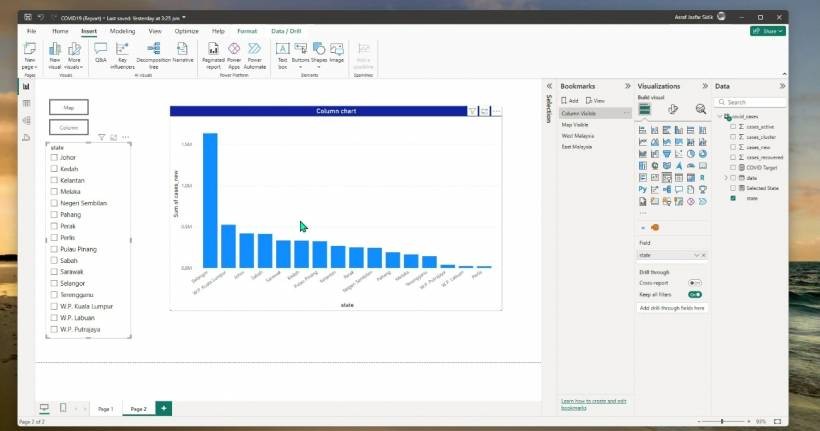If you're diving into the world of Power BI to analyze healthcare trends and statistics, you're not alone. The healthcare industry, whether public or private, thrives on data-driven insights. From patient demographics to disease outbreaks and hospital efficiency, the right datasets can help you uncover trends that lead to better decision-making.
As I'm learning Power BI myself with a focus on healthcare, I've come across several official Malaysian datasets that are goldmines for data analysts in this field. Whether you're a hospital administrator, a healthcare researcher, or a data enthusiast looking to understand Malaysia's general data landscape, this guide is for you!
1. Malaysia's General Data Sources
Before we get into healthcare, let's talk about the broader datasets that can help you understand Malaysia's economic, social, and environmental trends.
Malaysia Open Data Portal (data.gov.my)
This is Malaysia's primary open data portal, where you can access datasets across various categories, including:
- Demographics: Population distribution, birth rates, and census data.
- Economic indicators: GDP growth, unemployment rates, and trade statistics.
- Education: School enrollments, literacy rates, and academic performance.
- Transportation: Road traffic reports and public transportation usage.
- Environment: Air quality index and climate data.
Most of these datasets are available in CSV, JSON, or API formats, making them easy to load into Power BI.
Department of Statistics Malaysia (OpenDOSM) (open.dosm.gov.my)
OpenDOSM is a treasure trove of government statistics, providing data on:
- Consumer price index (CPI) and inflation rates
- Labor force participation and employment trends
- Tourism industry statistics
- Poverty and income distribution
For Power BI users, OpenDOSM provides structured datasets that can be transformed into interactive dashboards for deeper insights.
Malaysia Informative Data Centre (MysIDC) (mysidc.statistics.gov.my)
MysIDC is another government-backed repository offering social, economic, and environmental datasets. It's useful for:
- Urban development statistics
- Government spending and budget allocation
- Household income and living standards
2. Healthcare Data Sets for Public & Private Hospitals
Now, let's focus on the real deal—healthcare datasets that can be used by data analysts, hospital administrators, and policymakers.
Ministry of Health Malaysia (MOH) Open Data (data.moh.gov.my)
The KKMNOW platform under MOH provides access to real-time and historical healthcare data:
- Daily PeKaB40 Health Screenings: Health screening data for Malaysia's low-income group.
- Blood Donation Statistics: Number of donations categorized by blood type.
- Organ Donation Pledges: Total organ donor pledges across the country.
- Hospital Bed Occupancy Rates: Data on bed availability in public hospitals.
- Outpatient & Inpatient Statistics: Number of patients treated in government hospitals.
This is a must-use resource if you're working with hospital efficiency, patient volume, or public health trends.
Department of Statistics Malaysia – Health Data (archive.data.gov.my)
DOSM compiles healthcare data from multiple agencies, including:
- Dengue & Communicable Diseases Trends: Incidence rates from 2000 to 2021.
- Healthcare Workforce Data: Number of doctors, nurses, and specialists in public and private hospitals.
- Life Expectancy & Mortality Rates: Trends on Malaysia's overall health and aging population.
- Private Healthcare Spending: Insights into how much Malaysians spend on private hospitals and clinics.
World Health Organization (WHO) Malaysia Data (data.who.int)
If you're looking for international healthcare comparisons, WHO provides:
- Health Indicators: Malaysia's healthcare system compared to global standards.
- Non-communicable Diseases (NCD) Trends: Data on diabetes, heart disease, and obesity.
- COVID-19 Statistics & Vaccination Rates: Pandemic-related healthcare trends.
Malaysia Health Facilities Data (Humanitarian Data Exchange) (data.humdata.org)
For those working on healthcare accessibility or hospital location analytics, this dataset provides geospatial data of all public and private hospitals, clinics, and pharmacies in Malaysia. You can use it for mapping healthcare facility coverage in Power BI.
3. How These Data Sets Can Be Used in Power BI
If you're learning Power BI (like me!), these datasets can be used to create:
- Hospital Performance Dashboards: Track patient admissions, bed occupancy, and hospital efficiency.
- Disease Outbreak Heatmaps: Identify dengue, COVID-19, or other disease trends.
- Healthcare Accessibility Reports: Map out public vs. private hospitals for underserved communities.
- Medical Workforce Analysis: Analyze doctor-patient ratios and healthcare staff distribution.
- Financial Analysis for Private Hospitals: Use private healthcare spending data for business intelligence.
Power BI allows you to combine datasets from multiple sources, perform data modeling, and create interactive dashboards that can provide actionable insights for the healthcare industry.
Final Thoughts
For anyone looking to break into healthcare analytics in Malaysia, leveraging official datasets is key. Whether you're interested in public health trends, hospital efficiency, or private healthcare business intelligence, there's a wealth of open data available. Since I'm still in the learning phase of Power BI, I find that exploring these datasets helps understand industry challenges and trends while improving my data visualization skills. If you're also in this field, I highly recommend starting with Malaysia's healthcare datasets—they're comprehensive and provide real-world scenarios for Power BI practice.
Got a dataset I missed? Or any Power BI tips for healthcare analytics? Let's chat in the comments!
